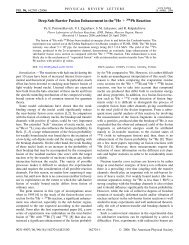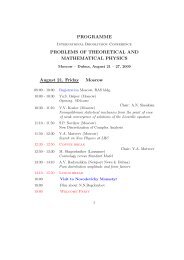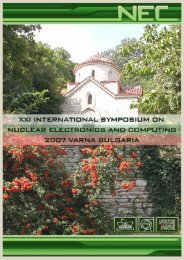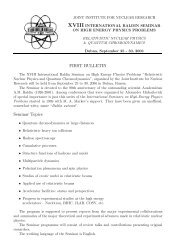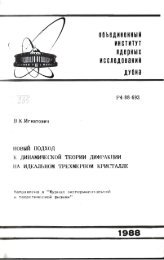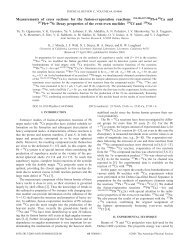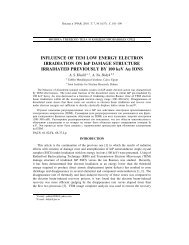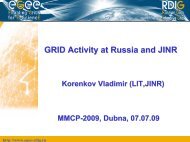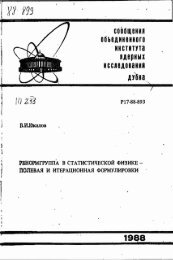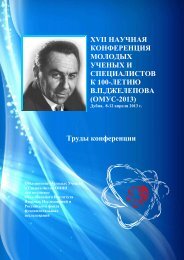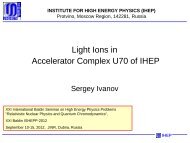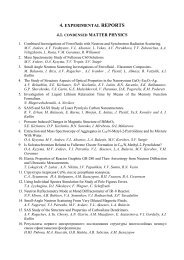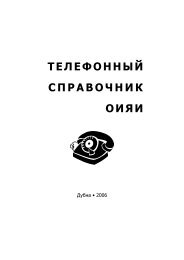di-neutron - Nrv Jinr
di-neutron - Nrv Jinr
di-neutron - Nrv Jinr
You also want an ePaper? Increase the reach of your titles
YUMPU automatically turns print PDFs into web optimized ePapers that Google loves.
( )<br />
G.M. Ter-Akopian et al.rPhysics Letters B 426 1998 251–256 255<br />
account the quality of these data, we <strong>di</strong>d not try to<br />
precisely fit these by varying the OM parameters.<br />
Instead, we took the OM potential that was found in<br />
wx<br />
4 6<br />
5 for the case of He q Li elastic scattering at<br />
E lab s 166 MeV as a basis. The <strong>di</strong>fferential cross<br />
sections calculated for our 6 He q 4 He system with<br />
this OM potential are shown in Fig. 4 by the dotted<br />
line Ž curve 1 .. The deviation of this calculated curve<br />
from our forward angle experimental points is at<br />
most about 30%. By varying some of the OM potential<br />
parameters within 10% we were able to easily<br />
eliminate this <strong>di</strong>screpancy. Curve 2 in Fig. 4 was<br />
calculated with the following parameters of OM<br />
potential taken in WS-volume form with Rsr 0 P<br />
Ž 1r3 1r3 . Ž .<br />
V<br />
A qA : V sy102.5 MeV 102.5 , r s<br />
P T 0 0<br />
0.522 fm Ž 0.522 ., a s0.920 fm Ž 0.820 .<br />
V , W0s<br />
Ž .<br />
W<br />
y13.0 MeV y11.77 , r s1.130 fm Ž 1.206 .<br />
0 , aW<br />
s0.500 fm Ž 0.950. Žthe numbers given in parenthewx<br />
5 for the<br />
ses are the parameter values used in<br />
6 4<br />
Liq He scattering .. In view of the <strong>di</strong>fference between<br />
6 He and 6 Li, such variations of the OM<br />
parameters are reasonable.<br />
Within the angular range of 1228FuCM<br />
F1558<br />
the calculated elastic scattering cross section varies<br />
between 5P10 y4 and 5P10 y6 mbrsr, whereas the<br />
experimental points lie in this range at a level which<br />
is by 10 2 -10 4 times higher. As was expected, there<br />
is no reasonable set of OM parameters that can<br />
reproduce the yield of the 6 He nuclei observed in the<br />
backward <strong>di</strong>rection. A change in the calculated<br />
dsrdV values by a factor of three to five for some<br />
local angular intervals in the backward hemisphere is<br />
the maximum that one can achieve by varying the<br />
OM parameters. This definitely means that the 6 He<br />
scattering events observed in this angular region are<br />
in fact the result of two-<strong>neutron</strong> exchange. The<br />
authors of Ref. wx 5 came to a similar conclusion<br />
about the role of the deuteron cluster exchange in the<br />
a-particle scattering observed at the backward angles<br />
6<br />
in the reaction LiŽ a,a . 6 Li.<br />
Assuming that the exchange of the two-<strong>neutron</strong><br />
cluster between 6 He and 4 He occurs via a <strong>di</strong>rect<br />
one-step mechanism, one should calculate a 9-<strong>di</strong>mensional<br />
integral consisting of entrance and exit<br />
<strong>di</strong>storted waves and the two-<strong>neutron</strong> wave function<br />
of 6 He to accurately describe the backward angle<br />
yield of 6 He nuclei. The theoretical estimates done<br />
Ž .<br />
within the three-body model aqnqn pre<strong>di</strong>ct two<br />
sufficiently <strong>di</strong>stinct spatial components for the 6He<br />
ground state wave function: Ž. 1 - a ’’<strong>di</strong>-<strong>neutron</strong>’’<br />
component in which the two <strong>neutron</strong>s are located<br />
close to each other Ž r ;2 fm .<br />
nn , with their centre of<br />
4<br />
mass being rather far from the He core ŽR nn ;3<br />
fm ., and Ž 2. - a ’’cigar-like’’ component Žr nn ;4.5<br />
fm, R ;1 fm. wx<br />
nn 2 . To calculate the cross-section of<br />
the <strong>di</strong>rect two-<strong>neutron</strong> transfer process, we used a<br />
simplified approach in which the two <strong>neutron</strong>s in<br />
6 He are treated as a cluster described by a wave<br />
function depen<strong>di</strong>ng on the R -coor<strong>di</strong>nate only Ž<br />
nn<br />
we<br />
leave a more sophisticated calculation for the future ..<br />
The transition amplitude was taken in the usual form<br />
DWBA 6<br />
²<br />
Žy. mod<br />
T Ž u . sS He P x r w R <<br />
2nŽ . ˜ k Ž f. 2n Ž f.<br />
V<br />
f<br />
Ž2n.a<br />
= <<br />
mod Žq.<br />
Ž R w R x r :<br />
i. 2n Ž i. ˜ k Ž i.<br />
.<br />
i<br />
The normalized model 2n-cluster wave function was<br />
calculated within the Woods-Saxon potential V Ž2n.a<br />
with the ra<strong>di</strong>us of 2 fm and <strong>di</strong>ffuseness of 0.5 fm.<br />
The depth of this potential was adjusted to reproduce<br />
a 2s-state with the bin<strong>di</strong>ng energy of 0.973 MeV.<br />
2s-state bound wave function consists of two peaks<br />
at R1,2<br />
which can be easily confronted with the two<br />
components Ž ’near’ and ’far’ located in R space.<br />
nn of<br />
6<br />
the total 3-body wave function of He wx 2 . To make<br />
the reaction mechanism more clear we decomposed<br />
mod<br />
the wave function onto two items - w Ž R.<br />
2n s<br />
w Ž R,R . yw Ž R,R . - where the functions w Ž R.<br />
1 1 2 2 1,2<br />
are peaked at R1,2<br />
and both have an appropriate<br />
asymptotic behavior at large <strong>di</strong>stance. Of course,<br />
such decomposition is an identical transformation of<br />
the bound state wave function, but now we can<br />
estimate correctly the contributions to the transfer<br />
cross section coming from the short and large <strong>di</strong>stances<br />
in R nn space. We <strong>di</strong>d not calculate a coherent<br />
sum of the elastic and transfer amplitudes Žimportant<br />
at the angular region of 808 - 1008.<br />
because their<br />
values <strong>di</strong>ffer drastically at the backward angles.<br />
Curve 3 in Fig. 4 shows the two-<strong>neutron</strong> transfer<br />
cross section calculated with the fully normalized<br />
model wave function. It is evident that the calculated<br />
cross section values are close to the experimental<br />
points in Fig. 4. Curve 4 in Fig. 4 shows the results<br />
of the calculation done with the model wave function<br />
from which the far- located ’’<strong>di</strong>-<strong>neutron</strong>’’ component<br />
was eliminated. One can see the deficit of two orders<br />
of magnitude in the cross-section values given by<br />
curve 4 showing that the contribution of the close



